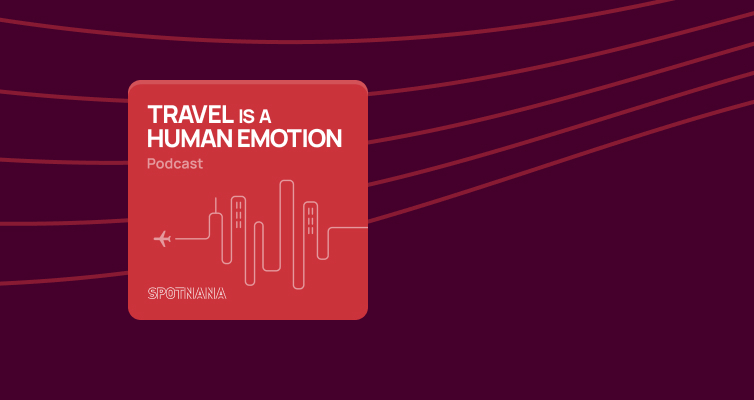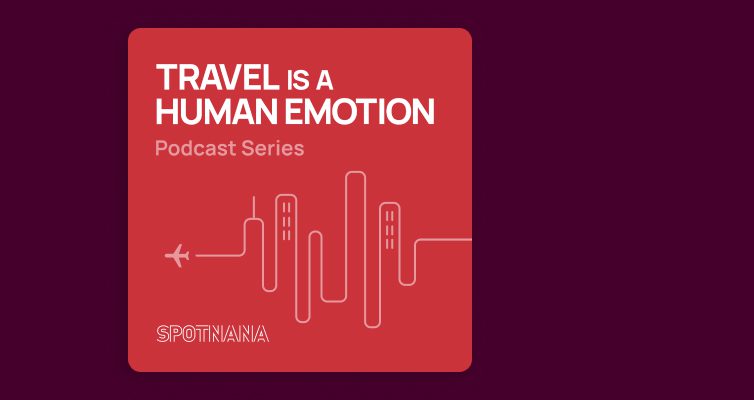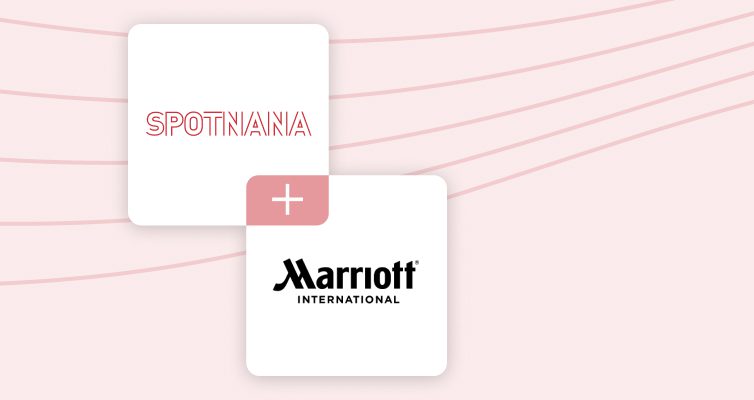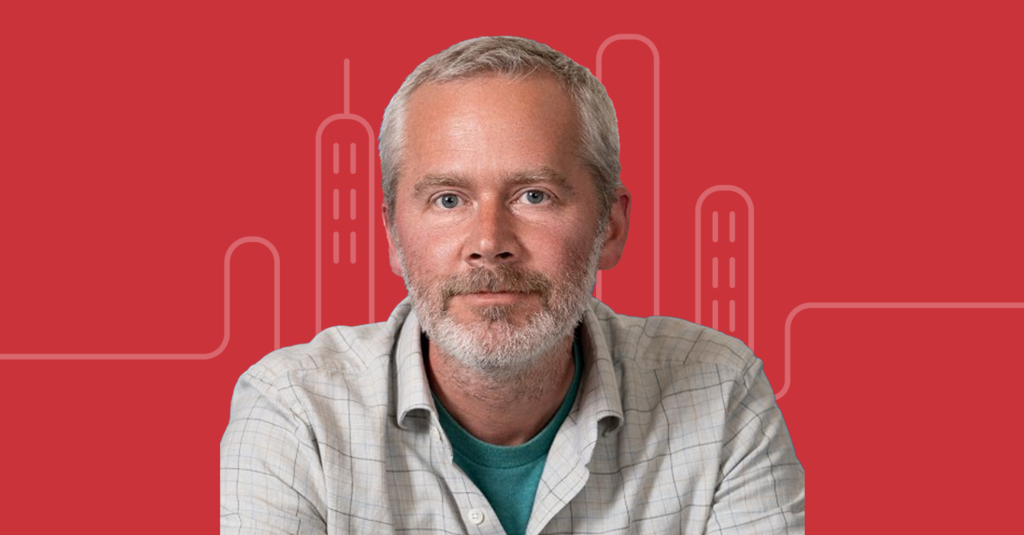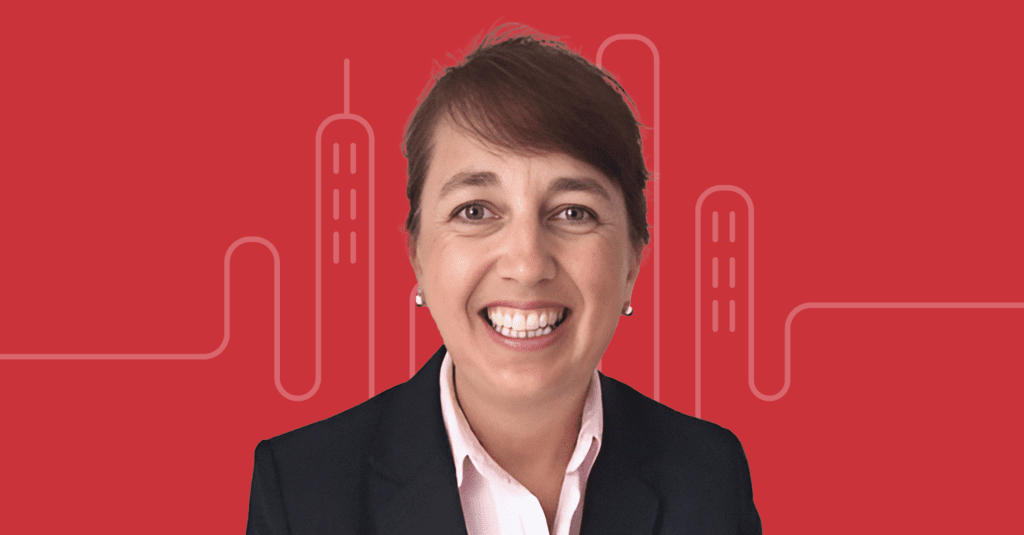EY’s Nicola Winchester on sustainable travel growth
Guest: Nicola Winchester, Global Travel, Meeting, and Events Leader at EY
Host: Justin Schuster, VP of Marketing at Spotnana
Length: 24:32
Nicola Winchester joins Justin Schuster to discuss the importance of corporate travel KPIs, how data informs EY’s travel program, and how to create a seamless experience for corporate travelers.
Justin Schuster
Welcome to the Travel as a Human Emotion podcast. My name is Justin Schuster and I’m the VP of Marketing at Spotnana. And my guest today is Nicola Winchester, Global Travel Meetings and Events Leader at EY. Nicola, I’m very excited to be spending time with you today. And you’ve been at EY for over 11 years and you’re coming up on your first full year of leading the global travel program at EY. And how has that first year gone? Have you achieved the goals that you set out for yourself in your first year?
Nicola Winchester
Yeah, it’s been a very different year, think, at EY. And certainly probably some unexpected turbulence, I would say, almost within our team. And actually not just within our team, but kind of going across our business. And the fact that, you know, like all businesses, we’ve had our own challenges and been hit by economic impacts, geopolitical impacts. And of course, that has an impact on what’s internally a support function. And so we sit within a support function. A lot of what has been happening this year is a kind of reorganization, restructuring, making sure that we are, I guess, fit for the future for our business.
Our business also had a very big leadership change right the way up to our CEO in July of this year. And so as always happens when you have new leaders coming into the business, that has a ripple effect as well into areas of the business. And so it’s been a challenging year, I would say.
But within that, though, I think what’s been really good about it is that we’ve still been able to make progress in our programs and ensure that we’re focused on everything that we need to be focused on for our objectives and making sure that how our KPIs roll up are actually lined up to our business overall. And so it’s definitely been a big year I would say.
And obviously stepping in after Karen Hutchings left was big shoes to fill for a very small person that she was, bless her. But yeah, it’s been a good year. I can’t believe that it’s gone as quickly as it has, to be honest.
Justin Schuster
I find that years go faster and faster the older I get. Well, you were talking about KPIs and EY’s travel program is very well known for setting some very exciting targets around sustainability. Can you just recap us on what those targets were and what’s the progress that you feel that you’re making towards?
Nicola Winchester
Yeah, that’s a really interesting one actually, Justin, because actually EY set very large goals out during the pandemic, as did many organisations when they committed to SBTIs. And so for us, we actually kind of went through that whole cycle as of up to this year, in fact, and actually where we landed within that, I believe that we utilised I think up to 93 % of our carbon emission budget, essentially.
We are now really kind of on that precipice of the next five year cycle. And so, you know, for our organization and it’s a massive focus area right now, it’s actually establishing right the way throughout our businesses as to what their goals look like now as it relates to carbon emission reduction and, you know, the whole impact point on the travel program. Because for us, obviously, we’re a client serving organization. So our people are our assets.
As a result of that, it means that our people need to be where our clients are. So travel is a big factor of that. But, for us, business travel actually equates to about 63 % of our overall scope three emissions. And so, as you can imagine with that, that puts a huge target and a huge focus on the area that I’m responsible for along with the team. And so we are literally working at the moment with various internal areas such as our responsible business team.
Really to make sure that those goals that are now being set to take us through the next phase are aligned to where we need to be by 2030. And I’d have to say that I think it would be tougher for this next phase in truth, given the fact that we had a pandemic in the last phase. And so that very much supported that reduction aspect. Whereas now we don’t have that. Businesses are generally growing back and are fairly buoyant.
We’re still growing as an organization in terms of our headcount as well. So balancing that ability to continue to grow revenue, continue to service our clients, but have a very sharp eye on sustainability is a big factor. It’s not just down to our team. It’s down to many areas of our internal business, but nonetheless, you know, our part within that as the travel meetings and events team is making sure that we’ve got the right data incoming and how we’re, you know, realigning those data points to use.
I guess more assured data. So moving away from those averages that, you know, a lot of organizations have been using to, to making sure we’re getting much more accurate data, the API data that we want to have. And then looking at some other, you know, third parties, as well as how we then map that into fiscal plans so that that can go down to a really granular level in our business. But equally, you know, the reality of it is, is that we will look at policy as well. We haven’t decided what our ultimate goals are as it relates to policy, but we do know that we’re going to need to evolve as an organisation. So that may see some impacts coming through in the policy pieces as well, actually. So it’s an interesting time, I think, for our organisation, given where we’re at at this particular juncture. But nonetheless, it’s an important one as well to make sure that we get it right now in terms of setting out those overarching goals.
Justin Schuster
That makes a ton of sense. And when you think about what helped you get to the point that you’re at, what were the changes that were implemented that you feel moved the needle the most?
Nicola Winchester
Yeah, I think for us actually, one of the things that was really impactful was that we built our own internal approval solution. And that was our EY Stat tool. Now that was actually a collaboration project that we did with IBM, who are a huge partner of EYs. They’re an alliance partner to EY. And the reason why we built that back in 2022, I think it was, that that tool was launched internally and it’s now rolled out to 58 markets we’ve got on that tool to date.
But that particular tool, it’s not just a tool that approves on a fiscal budget. We built in the carbon elements to it as well. But what it does is it makes the amount of carbon relatable. So when somebody’s requesting an approval, they’ll be able to see, what does that equate to as it relates to how many trees would need to be planted? How many fields is that from a forest clearing perspective? And so we’ve tried to make those really insightful in that element of the person that’s requesting a travel approval, but also the person that’s actually approving so that when they get that approval, they can see what the carbon impact is and also what the cost impact is.
That really has helped us. And within that, in those relatable insights, it outlines in there, if it’s a route that rail as an example is or should be utilised, it will give you the full view of the rail footprint, the economy class footprint, the business class footprint, so that you can really see from a decision making aspect what your impact point is going to be.
The other thing I would say that’s really critical in this space for any organization and us included is the data. You know, having the data and being able to share those insights with people that are actually traveling, the travelers themselves. And for us, you know, we have employee level dashboards that go out to those that are frequent travelers so that they can see what their impact is.
And so, you know, those are just two components, but big components of the programme really in helping us to make sure that we’re actually really informing our travellers as to what the impacts are on our business and on the planet effectively.
Justin Schuster
I love that. I love that you were able to help people really understand the choices that are available to them, guide them towards making more sustainable choices through the presentation of information that’s educational, giving them the power to make the choice, but off of real data. And as I learn more about your program, the work that you’ve done with data, I think is super impressive. Among the things I saw was this work that was done to really map out all of the city pairs and look at the rail options, map to those to be able to give people the direct comparison and really groundbreaking.
Nicola Winchester
That’s exactly what we’ve done. Yeah, and as an example of that, you ‘ve seen particular markets that have, you know, actually, if I look at Poland as a great example, our rail adoption went up by about 70% in Poland, just from implementation of the approval tool. And we really do push hard to steer people to making the right choices. That’s really important for us as an organization. And it’s going to be, you know, so much more important as this next phase, kind of like, continues to evolve. But I think, like most organisations, that’s been very centred on air, air to rail particularly. But in this next phase, we’ll get a lot more granular in the data as it relates to meetings and events footprint, hotel and lodgings footprint. And so that’s something that I think the better the data is getting at an industry level, the more organisations like us can benefit as to how we educate our people.
Justin Schuster
Do you find that the data exists out there at a level that you can take action on, are you having to do something similar to what you had to do with air, get it yourself?
Nicola Winchester
Yeah, some combinations are actually getting better. You know, there is definitely organizations out there now in this space that operating that we’re partnering with because, you know, for us, we, we do a lot of build ourselves, you know, we’ve always done that in our program, but equally, we also want to make sure that we’re supporting at an industry level. And so there are some good third parties out there now that, you know, we are now looking to partner with and investigate that really can help with that journey as well. So it’s a bit of both actually, a bit of a combination of both.
Justin Schuster
Earlier in our conversation, you were talking about how important people are to what UI does in the world as a consulting organization. Your people and the quality of your people really relate directly to the services that you can offer and deliver. And I saw a statistic, which just blew me away that you have nearly or around 400,000 employees now. Hiring must be a big focus for the organization. Are you involved a lot in recruiting travel? And so what are the things you’re focused on focusing on trying to improve in that area?
Nicola Winchester
Yeah, that’s an interesting one. I have to say, I yes, you’re absolutely right. Recruitment is a big area for our organisation. And to give context to that, when I joined EY back in 2013, we were 160,000 people. Today, we are, to your point, 400,000 people. So you can understand that growth is significant. And a big part of that growth does come through graduate programmes.
And so many of our major markets have large graduate programs. The US is a great example of that. And I have to say, you know, this has been a really troublesome space, I think is the best word that I can use in the fact that there’s never really been any great solutions out there that really, you know, support the graduate recruit piece, because they’re non-profile travelers at the end of the day. And so, you know, it can be quite a clunky process.
And at the moment, we are partnering with one of our major providers to look at a solution that they have. And actually the solution that our partner had was actually a kind of solution that they were targeting for the kind of mid market and small medium sized enterprises. But what we’ve done is kind of flipped the tool so that we are going through pilot stage at the moment with this particular tool in the fact that it would enable a graduate, a non-profile traveler to go into the tool, make their booking but then the payment element of it is via a virtual token.
That impact point on people that essentially may not have their own credit card to make payment or have a lot of money in their bank account, there’s a real seamless kind of solution for them so that it doesn’t impact them personally having to go through a reimbursement process. And so that’s something that we are trialling at the moment with a small user group. We’re not there yet for sure.
And we know that it will have some tweaks, but we’re pretty excited about that because if we can get this right in a major market like the US, for example, then it’s something that we can actually take forward elsewhere. But equally, one of the things that we’re realistic to is it’s not always the case that one size fits all or it’s the same solution everywhere. You have to look at what’s actually relevant on a market by market basis. And so that may be a perfectly usable tool in a number of markets, but not necessarily elsewhere or in other markets.
We’re open minded enough to think, okay, well, is that something that we can lift and shift and move it here? Or do we need to look at something else for a particular market? And so there is a lot going on in this space at the moment, because we really want to make sure that this is a great experience. Really is that first entry point for a graduate to be coming into EY University. That doesn’t say a lot or, you know, it doesn’t feel good, I think, for somebody that’s actually starting their, you know, their career, their, first part of their career. And so that’s something for us that we’re pretty excited about to see how this is going to evolve.
Justin Schuster
I think this is an area of huge opportunity for innovation in the travel industry. It’s great to hear that the partner you’re working with is offering some solution that you feel you can adapt and expand for your needs. This is an area that Spotnana is looking at as well, beyond recruiting travel, that bigger area of specialty meetings and events.
Nicola Winchester
Exactly. Yep.
That’s exactly it. Sometimes I think you also have to be open minded in terms of what looks like some technology or a tool may not be something that has been designed for that purpose, but can you repurpose it? And we’re even looking at some of that with our own internal technologies where we feel just simple things in the past like project plan trackers. Actually, there’s other purposes that we can use some of this stuff for. I agree with you, Justin. I think the graduate recruitment space is a major opportunity at the moment.
Justin Schuster
And I love that you’re so forward looking and you can see something is maybe not the full solution, but it’s partly there and you’re willing to work with the technology partners in your portfolio to help close that gap.
Nicola Winchester
Yeah, and we have to be realistic in the fact that, if we sit and wait for perfect to happen, we would never do anything. We would never get to that. And that can sometimes be difficult, particularly in the industry landscape within which we all work because, you know, the end user doesn’t necessarily understand that you have to iterate. That said, though, we’re better off having something that’s 80% that we can iterate on rather than trying to wait for something that’s perfect, that actually by the time you get to perfect, it’s actually outdated. And so that’s something that we’ve always embraced in our kind of like ethos and we’ll continue to do that.
Justin Schuster
Well, it’s a good opportunity to maybe segue to the world of content, which is definitely not all the way to perfect. There’s a lot of orientation that continues to happen. I think this year was a big year for NDC integrations to start emerging more through the GDSs and Spotnana spoke a bunch of those as well. Where are you in your journey with NDC and with content more broadly and what do you hope to achieve?
Nicola Winchester
Yeah, and I mean, I guess it’s another one of those things that you’re absolutely right. And actually the content fragmentation piece or segmentation, whichever way you want to look at it. We haven’t nailed this yet. We’re trying to do our best with it as an organization, which is I think what all organizations are trying to do. You know, I think for travel programs, there are certain components within a program that, you know, you can’t give up on. And that’s the duty of care to employees, the data.
And the experience actually, what you don’t want to do, you might be able to segment out a program, but are you going to confuse the hell out of people? And that’s not what we want to do. We want the experience to feel seamless. Now what seamless looks like to the end user, maybe in the future, something that’s a bit more segmented in the background. And at the moment, we haven’t resolved for that fully. We are doing our best in markets where it makes sense with the different tools and technologies and, you know, talking to our suppliers.
That’s, I think, the biggest thing for us is making sure that we’re educated on where our partners are at. And so, you know, this is going to be something that I think will continue to evolve. I have to say, though, I think the industry is getting there. This year definitely feels less confused than it has even felt, for example, to last year. And so I think the industry is now getting to its own point of understanding that, you know, we’re going to have to do things a bit differently going forward.
And actually that’s okay. But as long as we can get what we need and not, not, not impact on the user experience, that’s the key thing for us. And so, you know, it’s, it’s going to be probably in bits and pieces in some regards in the future, but I think that’s okay. I think there are some exciting opportunities with what’s doable now with things like next-gen AI or how about how you build that entry point into a program as such.
And so that’s something that we haven’t figured out totally yet, but we’ve got a lot of people that are continuing to look at that. And some of that, again, working with different organizations and talking to the industry. Johnny and I have been on a number of panels together talking about this particular point. And I think all of us agree that actually this is an industry-wide solution that’s needed and that solution won’t be a one-size-fits-all again. I know nothing in our industry can be considered to be that any longer I don’t think.
Justin Schuster
And when you think about 2025, have you set your goals yet? Is AI a piece of that?
Nicola Winchester
Yeah, most definitely. Yeah, absolutely it is. We work to our fiscal year in terms of our goal setting and our fiscal year is from July through to June of each year. So we’re already halfway through FY 25 for us. And so when we looked at what those kinds of goals were as we set out and actually for me coming in as the new leader into the program, that’s one of the first tasks that I had to undertake.
And our business was evolving at the time as well in having new leaders coming in at the kind of like the most senior levels. And so that has meant a big kind of internal and external rebrand focus for our organization as well. And so we’ve needed to make sure that our KPIs are fully aligned into what our business drivers are. But that says some of the things that we’ve broken out of our service at the end of the day, we’re a travel program and we always try to be innovative.
However, service is paramount. So service is absolutely a focus for us. As I think about something that we’ve got much more focused on is we’ve always assumed that the user experience was there, but actually user experience is something that we now make much more targeted, making sure that we’ve got, you know, individuals within our team fully focused on, what does it mean if we actually build or implement a tool? What does that have as a downstream impact on the user?
Where does it benefit them? So user experience is critical for us. And then things like the sustainability agenda, obviously that’s a huge focus as well in making sure that we’re tuned in to the industry, tuned into our business, tuned into our service lines and actually how we’re going to support them. But also then you have the kind of fiscal elements that none of us can deny, especially those of us that sit within a program that sits under supply chain services or procurement.
We’ve all got big fiscal plans that we have to actually report up to drive value for the business. And I outline it more as driving value rather than reducing cost. For us, we want to make sure that whatever we’re doing has a tangible value. And some of that value has changed in our business. And so it’s not now all about what discount did you negotiate with your supplier at the front end? Some of that value is bigger.
But within that, actually, that’s complicated our landscape more because how you measure has actually got more complicated with that. And so we’ve got a very robust set of KPIs that we are measuring to every single month in a really detailed way so that we can report that back to our businesses and so that they can see for us what value it is that we’re actually delivering as a support function of our business.
Justin Schuster
As you look at value, are you working with your suppliers to figure out ways to add in additional amenities that are specific to EY?
Nicola Winchester
Correct. Yeah, absolutely. I mean, we try to make sure that we capture all of that, you know, anything that brings value for our individuals. And that could be anything from, you know, we don’t just look at what we’re doing at a corporate corporation level. We also try to negotiate where we are, where it’s possible benefits that are able to be utilized for people if they’re traveling for leisure purposes. And that’s not always doable. You know, you have to be respectful of your partner, your partners that you’re working with in that space.
But if it’s something that they’re comfortable with, then we embrace that as well. We are understanding of the fact that for our people that are serving our clients in particular, they could be away from home 70% of the year. And therefore, what does value feel like to them? And how do they feel like they’re being taken care of? And so where we can have those kinds of tangible value and benefits, that’s something we absolutely embrace.
We work very closely with all of the different sectors of suppliers from lodgings to airlines to TMCs, know, all of them as to where we can add that kind of extra value.
Justin Schuster
Some of your travelers are spending 70% of their time on the road. This is the Travel Is a Human Emotion podcast. When you think about the connection between travel and human emotions, what resonates most with you?
Nicola Winchester
I think the thing that resonates most with me and it’s something that hasn’t changed, it is an emotional thing. Actually, when somebody’s traveling, the smallest thing can create an emotional reaction, either positive or negative. And that’s certainly something that for somebody to that point, you know, if they are away from their family for a significant amount of time. If it’s a feel-good thing, it makes a massive difference. If it’s a feel-bad thing, it makes a big impact.
That emotional relationship to what we do as a service provider in our business is critical. It’s critical to actually the success of us as a team and how we’re viewed within our business and at an industry level. so, you know, equating that kind of emotional tie, that’s why we’ve got somebody now within my leadership team that is actually focused on user experience. You know, that’s something we never used to have something specifically kind of, or somebody specifically dedicated to that. But that’s something we are getting much more tuned into, that the user experience is, it is your key success factor.
Justin Schuster
Nicola, thank you so much for your time today. I really enjoyed our conversation and I hope you have a wonderful day. Thank you.

